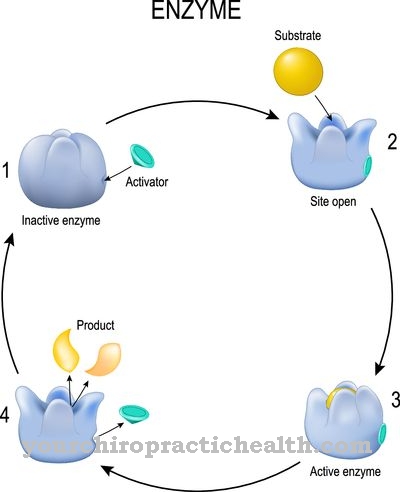Under Vaginal infections or. Vaginal infections all diseases are included in which inflammation occurs in the vaginal area. The causes are varied and numerous, so a detailed gynecological examination is essential in order to be able to treat the disease in a targeted manner. However, the chances of recovery are good in Germany.
What are vaginal infections?
.jpg)
© Olga - stock.adobe.com
Vaginal infections are among the most common clinical pictures that lead patients to gynecologists. Various causes, including excessive intimate hygiene, mechanical overstimulation - the so-called honeymoon syndrome - and the use of antibiotics, lead to a disruption of the vaginal flora.
A healthy vaginal flora is primarily characterized by the number of lactic acid bacteria. These keep the natural acidic environment of the vagina in a pH range of 4 - 4.5 and thus prevent the multiplication of harmful germs.
Harmful pathogens can multiply in a disturbed vaginal flora and trigger various inflammatory vaginal infections. The symptoms are varied and depend on the particular pathogen.
causes
The main pathogens of Vaginal infections should be briefly presented below. All of them lead, in excessive numbers, to increased discharge, burning and / or itching of various degrees, and swelling or redness.
A typical bacterial vaginal infection, particularly caused by Gardnerella vaginalis, is the fishy odor of the discharge. The main triggers of viral vaginal infections are herpes simplex viruses and human papilloma viruses. Herpes simplex is shown by the blisters on the vagina known from cold sores.
Human papilloma viruses mostly cause benign genital warts, which are more visually disturbing and rarely cause symptoms. However, cell changes and the resulting cervical cancer can also occur.
Most vaginal infections are caused by the yeast Candida albicans, which is characterized by discharge that looks like cottage cheese and painful urination.
If the vaginal infection was caused by protozoa that can be found in the mucous membranes, the discharge is pungent and frothy. Another risk factor is the transmission of pathogens during sexual intercourse.
Typical & common vaginal infections
- Bacterial vaginosis
- Inflammation of the vagina (vaginitis)
- Vaginal fungus (vaginal fungus)
- Vaginal discharge
- Genital herpes (genital herpes)
- Chlamydia (chlamydial infection)
Symptoms, ailments & signs
Depending on the type and severity, vaginal infections can cause different symptoms. Bacterial vaginosis manifests itself primarily through skin irritation in the abdomen, such as pain, itching or redness. A thin, whitish-gray discharge can also be noticed.
There is also an unpleasant, sourly smelling intimate odor. The doctor can determine a significantly increased pH value of over 4.5 in amine vaginosis. A fungal infection of the vagina causes severe itching and burning in the vagina and the surrounding genital area. There is also swelling and redness.
In the area of the labia and clitoris, deposits or crusts can form, which occasionally smell unpleasant. A fungal infection is also manifested by yellowish-white or gray discharge from the vagina, which is usually odorless. Viral vaginosis causes similar symptoms, but is more protracted. An infection with trichomonads is symptom-free in 85 percent of cases.
Possible signs include vaginal discharge, painful urination, and intense itching. Vaginal infections usually go away after a few days. The typical symptoms cause the affected women to feel very unwell. However, vaginosis is usually relatively harmless and easy to treat. Long-term effects or chronic complaints are unlikely.
Diagnosis & course
Based on the symptoms described, the gynecologist receives initial information about the causative agent of the Vaginal infection. In particular, a precise description of the outflow observed and the sexual behavior before the onset of symptoms are important.
To diagnose a disturbed vaginal flora, define the pH value and reliably determine the trigger, the gynecologist takes a smear from the vagina and creates a bacterial and fungal culture. A detailed examination of the vagina is also helpful; in the case of an infection caused by protozoa, the swollen, highly sensitive vaginal mucosa is noticeable.
An infection with herpes simplex or human papilloma viruses also shows up on the physical examination through the typical skin symptoms. The prognosis is usually good, only an infection with human papilloma viruses can lead to serious illnesses.
Complications
Vaginal infections usually do not cause major complications. Bacterial vaginosis initially leads to pain when urinating or during sexual intercourse and can severely impair wellbeing. Chronic illnesses can lead to psychological complaints such as depression or inferiority complexes.
The greatest danger in bacterial vaginosis is gynecological inflammation. The external genital area, the vaginal entrance, the fallopian tubes and the mucous membrane of the cervix are particularly susceptible to infection. If a vaginal infection occurs during pregnancy, there is an increased risk of miscarriage. In addition, there is a risk that those affected will infect their partner unnoticed and thereby fall ill again themselves.
When treating a vaginal infection, the risks come from unsuitable and improperly applied treatments. Excessive intimate hygiene can in some cases exacerbate the symptoms. The use of irritating care products can promote irritation and, in the worst case, lead to the infection spreading to other parts of the body. The use of antibiotics is associated with various side effects and interactions. For example, stomach pain, diarrhea or skin irritation often occur.
When should you go to the doctor?
Vaginal infections make it necessary to go to the gynecologist at the latest when noticeable symptoms occur. Reasons to consult a specialist include itching or burning in the vagina or pain. However, other possible symptoms of a vaginal infection are also a reason for those affected to see a doctor. These include, for example, discharge, changed smells or changes in the consistency of the mucus. Basically, all changes to the vagina are considered a medical reason to see a gynecologist.
In addition, the number of possible vaginal infections is large. Most of them are relatively symptom-free or only occasionally have noticeable symptoms. Accordingly, even the smallest changes should be used as an opportunity to have a check-up carried out. Most vaginal infections are also harmless and easy to treat.
However, a quick trip to the doctor is always advisable. On the one hand, this protects possible sexual partners from infection. On the other hand, there are also infections that can seriously damage the vaginal tissue over time. In addition, bacterial infections, for example, can also migrate from the vagina. Co-infection of the uterus, for example, should be avoided as a matter of urgency.
Treatment & Therapy
The therapy of Vaginal infection is based on the identified pathogen and is mostly aimed at the person affected and their sexual partners. It is advisable not to have sexual intercourse until the symptoms have subsided.
It is also important to harmonize the vaginal flora by avoiding causative factors and, if necessary, supporting regeneration with suppositories with lactic acid bacteria.
Vaginal infections caused by bacteria and infection with protozoa are treated with antibiotics that are given as tablets, vaginal creams or suppositories. The bacterial infection is only treated in non-pregnant women if the patient is suffering from symptoms, and always in pregnant women.
The treatment of infection with human papilloma viruses or herpes simplex can be carried out by the patient with virostatic ointments or tablets. Medical treatment with trichloroacetic acid or laser therapy is only necessary in severe cases; the affected areas of skin can also be surgically removed.
Candida Albicans is treated with antifungal drugs in the form of a cream, suppository, or tablet. From a homeopathic point of view, grapefruit seed extract is also recommended.
prevention
To one Vaginal infection To prevent this, we recommend healthy intimate hygiene, caution when choosing sexual partners and protected sexual intercourse. There is no 100% protection against human papilloma viruses, so all girls should have a vaccination before their first sexual intercourse. Regular gynecological examinations also protect by checking the ph value of the vagina.
Aftercare
The physiological vaginal flora can be negatively influenced by many factors (e.g. environmental influences, sexual behavior, stress, diet). Follow-up care should therefore aim to maintain the natural, physiological environment of the vaginal flora in order to avoid reinfection. It is estimated that there is a recurrence rate of about 60 percent after vaginal infection.
For prophylaxis, preparations containing lactobacilli can be administered in the form of vaginal suppositories or tablets. These should cause an increase in the physiological bacterial flora of the vagina. Said preparations should be administered over a period of at least four weeks. There are even recommendations that speak of a period of six to eight weeks.
Another approach to follow-up care or relapse prevention is the physiological acidification of the vaginal pH value. Here the physiologically low pH value of around four should be achieved / maintained. Lactic acid preparations exist in the form of tablets or suppositories. Since vaginal germs prefer a warm and humid environment, tight, airtight clothing in the intimate area should be avoided.
Excessive intimate hygiene is counterproductive; this could have an unfavorable effect on the pH value. It is advisable to change your underwear daily and wash it at higher temperatures. If you use panty liners, make sure you change them regularly and use breathable material.
You can do that yourself
Vaginal infections can be caused by fungi or bacteria and cause the unpleasant symptoms. All vaginal infections are usually easily accessible to women to help themselves. In all cases, however, the following applies: The diagnosis by the doctor must be clearly confirmed in advance. If the disease flares up again, self-help can also replace a doctor's visit.
The following applies to most vaginal infections: They disrupt the natural balance in the environment of the vaginal flora. Self-help is therefore primarily aimed at bringing this milieu back into the physiological range. Lactic acid is an important factor here. This can be inserted into the vagina in the form of tablets and suppositories. A normal tampon, which has been dipped in natural yoghurt before insertion, offers natural help. Thanks to its cooling effect, it can also relieve the itching that is often associated with vaginal infections. The natural yoghurt can also be used for prophylaxis outside of acute infections. It has a positive effect on the vaginal flora.
Hygiene is an important factor in vaginal infections, but should not be overdone with harsh cleaning products. Mild cleaning with lukewarm water is sufficient. In the event of an acute infection, underwear should be changed daily and washed at the highest possible temperature. Cotton is more advantageous than synthetic fiber here.

.jpg)











.jpg)

.jpg)
.jpg)











.jpg)